
Posted on 01/30/2024 8:44:30 AM PST by Red Badger
The treasure trove of images reveals intricate patterns of gas and dust in spiral galaxies beyond the Milky Way in unprecedented detail.
Recently released James Webb Space Telescope images of 19 distant galaxies shine an entirely new, dynamic and vibrant light on these gorgeous realms. The treasure trove of cosmic portraits taken by this $10 billion telescope reveals highly detailed, and quite breathtaking, face-on views of the spirals as seen from the instrument's vantage point in space.
These JWST images had particularly excited astronomers while in the process of being delivered because they emphasized that no two galaxies are the same when viewed with the kind of precision the JWST can offer.
The observations, part of the Physics at High Angular resolution in Nearby Galaxies (PHANGS) program, especially highlight structures of gas and dust within these galaxies, offering astronomers hints at how spiral galaxies like the Milky Way form stars.
"The JWST's new images are extraordinary," Janice Lee, project scientist for strategic initiatives at the Space Telescope Science Institute in Baltimore, said in a statement. "They're mind-blowing even for researchers who have studied these same galaxies for decades. Bubbles and filaments are resolved down to the smallest scales ever observed and tell a story about the star formation cycle."
The images show glowing orange lanes of dust, captured with the JWST's Mid-Infrared Instrument (MIRI).

A mosiac of 19 JWST images of spiral galaxies (Image credit: NASA, ESA, CSA, STScI, Janice Lee (STScI), Thomas Williams (Oxford), PHANGS Team)
The same instrument also captured stars that are still in the process of forming, encased in envelopes of gas and dust from which they are gathering mass. Those envelopes can be seen as red "seeds" on the peaks of dust lanes.
"These are where we can find the newest, most massive stars in the galaxies," Erik Rosolowsky, a professor of physics at the University of Alberta, said in the statement.
This aspect of the newly imaged spiral galaxies is particularly prominent in the image of barred spiral galaxy NGC 1300, located 69 million light-years away in the constellation Eridanus.
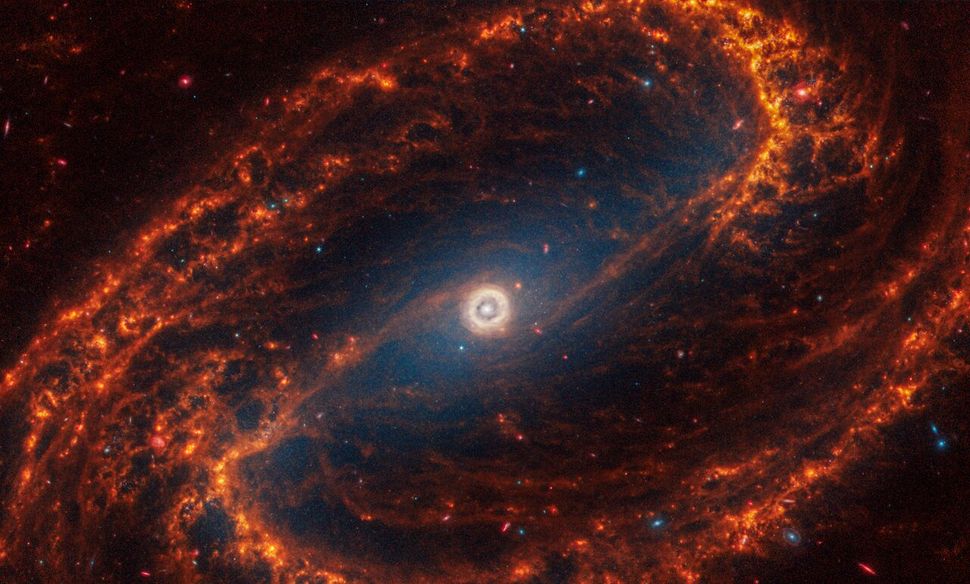
The barred spiral galaxy NGC 1300 with infant red stars seen at the tips of orange dust lanes (Image credit: NASA, ESA, CSA, STScI, J. Lee (STScI), T. Williams (Oxford), PHANGS Team) Millions of more mature stars are seen in the images as bright blue jewels shining through orange lanes of gas and dust, captured by the JWST's Near-Infrared Camera (NIRCam). Some of these blue stars are clustered together, while others are spread out through their home galaxies.
These hot blue stars can be seen clearly in the JWST PHANGS image of the spiral galaxy NGC 7496, which is 24 million light-years away from Earth in the constellation Grus.
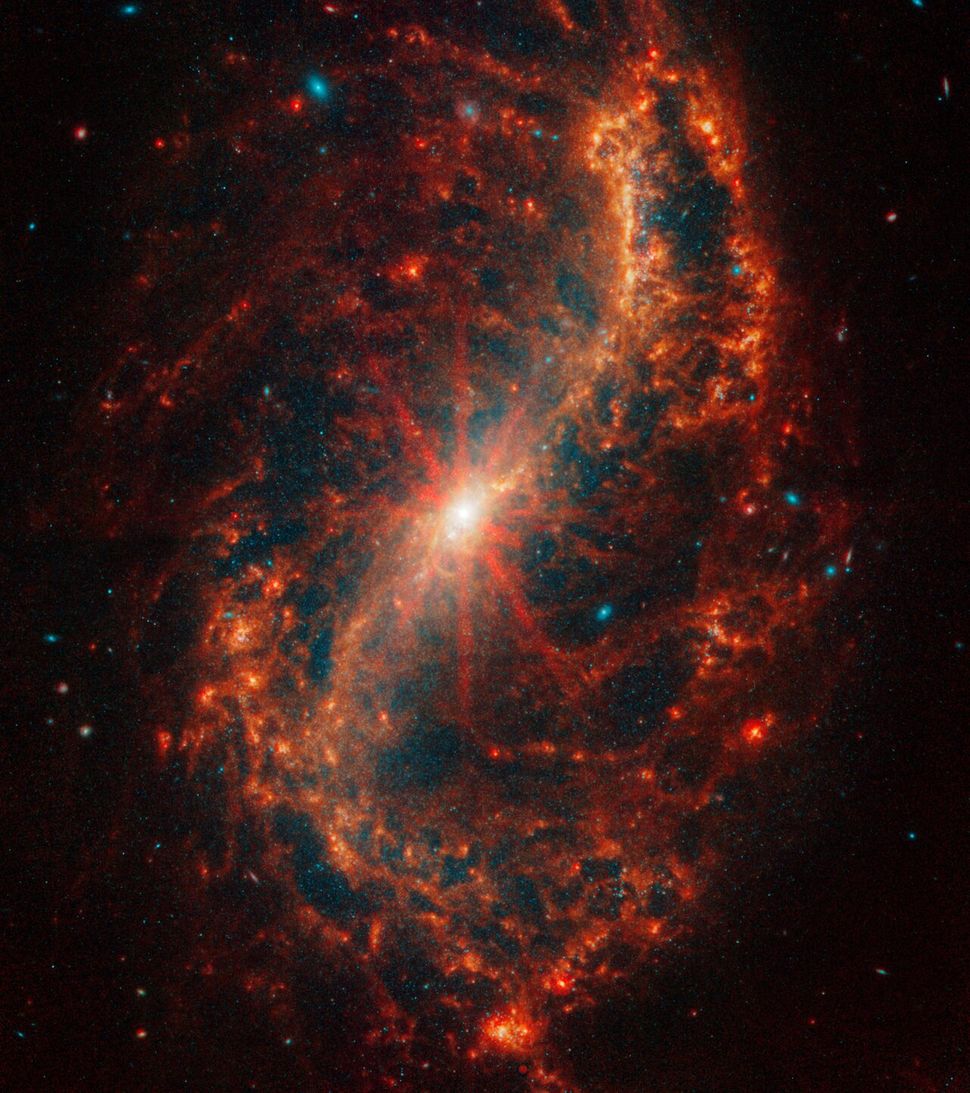
Older blue stars punch through the orange gas of NGC 7496 (Image credit: NASA, ESA, CSA, STScI, J. Lee (STScI), T. Williams (Oxford), PHANGS Team) To the amazement of the astronomers who examined these JWST-imaged spiral galaxies, the powerful space telescope also spotted several voids within gas and dust lanes.
"These holes may have been created by one or more stars that exploded, carving out giant holes in the interstellar material," Adam Leroy, a professor of astronomy at Ohio State University, said in the statement.
One of the galaxies imaged by the JWST as part of the PHANGS program, NGC 5068, which is located 20 million light-years from Earth in the constellation Virgo, appears to be dominated by such large voids.
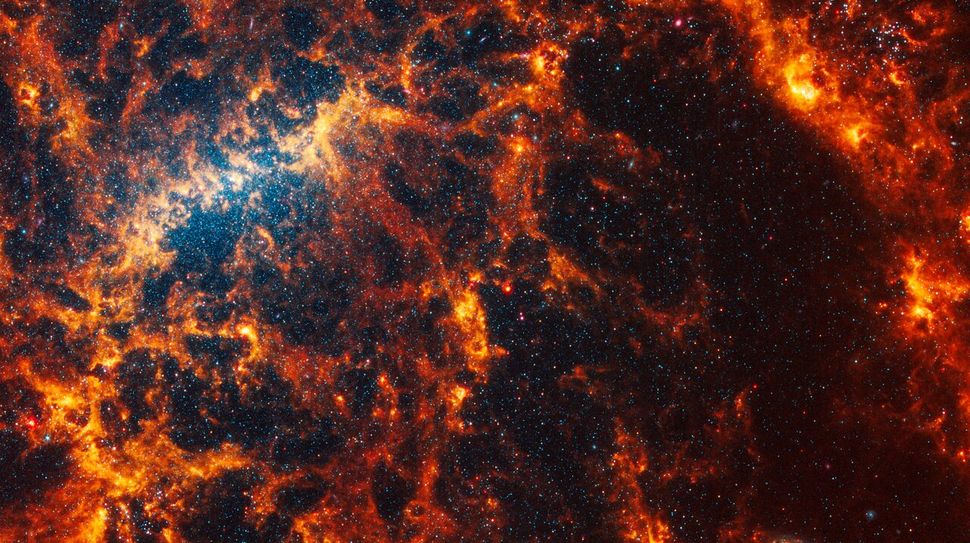
The spiral galaxy NGC 5068 is dominated by holes and voids that may have been cleared by exploding massive stars. (Image credit: NASA, ESA, CSA, STScI, J. Lee (STScI), T. Williams (Oxford), PHANGS Team) Of course, one of the most stunning features of any spiral galaxy concerns the "arms" that radiate out from the central nucleus of densely packed stars to form an iconic spiral. By tracing these arms, astronomers can find extended regions of glowing gas and dust.
"These structures tend to follow the same pattern in certain parts of the galaxies," Rosolowsky explained. "We think of these like waves, and their spacing tells us a lot about how a galaxy distributes its gas and dust."
Because dense clouds of gas and dust collapse to form new stars, studying these structures in detail could provide key information about how intense bursts of star formation are triggered, maintained, then shut down in galaxies.
These spiral arms have arguably never appeared more dynamic and vibrant than they do in the new JWST image of NGC 628, a spiral galaxy located 32 million light-years away in the constellation Pisces. In the image, the galaxy's arms appear to be spritzing gas and dust like bright orange splashes of spray paint.
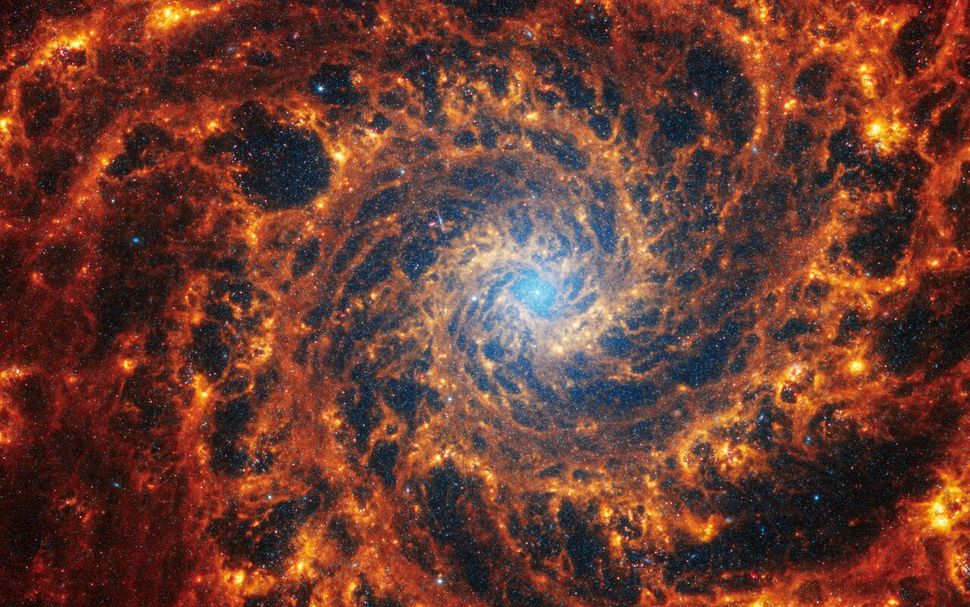
(Image credit: NASA, ESA, CSA, STScI, J. Lee (STScI), T. Williams (Oxford), PHANGS Team) Additionally, some of the galaxies seen by the JWST as part of this observing program show pink-and-red diffraction spikes spread throughout their central region.
"That's a clear sign that there may be an active supermassive black hole," Eva Schinnerer, a scientist with the Max Planck Institute for Astronomy, said in the statement. "Or, the star clusters toward the center are so bright that they have saturated that area of the image."
This can be seen in the JWST image of NGC 1365, which is located 56 million light-years away from Earth in the constellation Fornax.
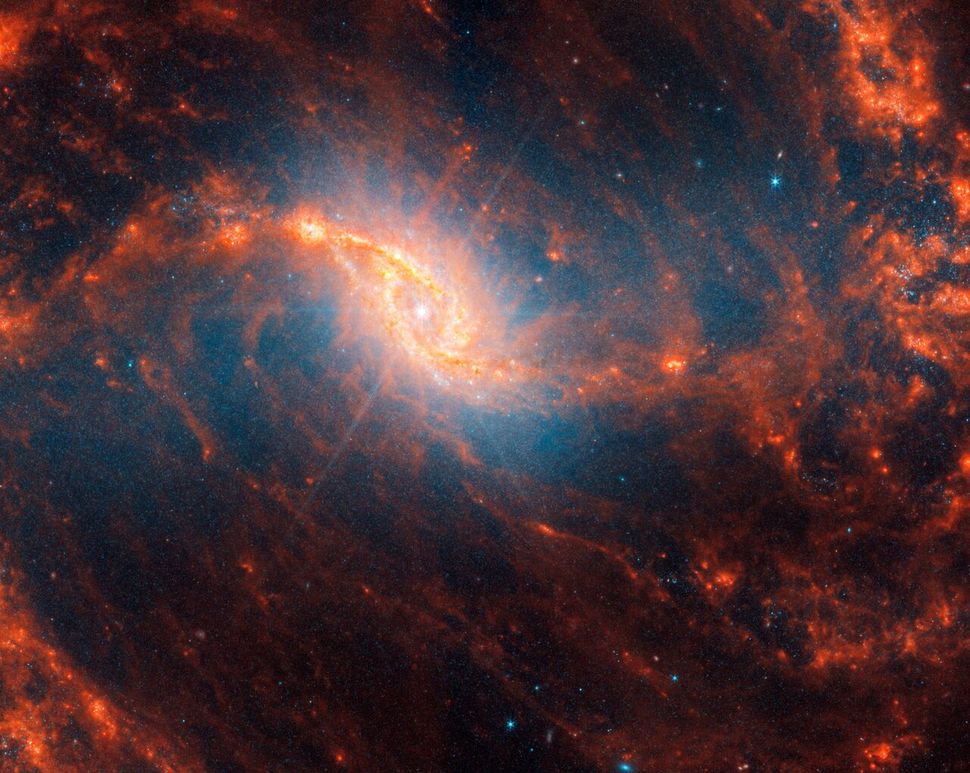
The spiral galaxy NGC 1365 with pink diffraction spikes that might indicate an active supermassive black hole at the heart of this galaxy (Image credit: NASA, ESA, CSA, STScI, J. Lee (STScI), T. Williams (Oxford), PHANGS Team) One thing that seems to be apparent from these 19 spiral galaxy images is that galaxies appear to grow from the inside out, meaning the birth of stars starts at the hearts of galaxies then radiates outwards through those spiral arms.
This means that the further from a galaxy's core a star is the more likely it is to be relatively young with ancient stars mostly gathered at the hearts of galaxies.
"I feel like our team lives in a constant state of being overwhelmed —in a positive way — by the amount of detail in these images,” homas Williams, a postdoctoral researcher at the University of Oxford, said in the statement.
The full catalog of new JWST spiral galaxy images is available here.
Join our Space Forums to keep talking space on the latest missions, night sky and more! And if you have a news tip, correction or comment, let us know at: community@space.com.

Spiral galaxy NGC 1087 is 80 million light-years away in the constellation Cetus. NASA, ESA, CSA, STScI, Janice Lee (STScI), Thomas Williams (Oxford), and the PHANGS team
Webb Ping!.....................
MORE Here!...........
Pretty cool, actually.
Has anyone figured out how big space is ? Is it infinite?
How would we know when we got to the end of it?
Is there a wall?...............
Or a cliff?
interesting how every single one has the same amount of saturation(orange) in it... they are nice pics, but they are not real.
True- the coloration is for demonstration purposes only- the article shoulda made that clear-
So we have a Webb telescope and a Hubble telescope. Imagine what a Webb Hubble telescope could see.
It’s turtles all the way down.
 Face-on spiral galaxy, NGC 628, is split diagonally in this image: The James Webb Space Telescope’s observations appear at top left, and the Hubble Space Telescope’s on bottom right. Webb and Hubble’s images show a striking contrast, an inverse of darkness and light. Why? Webb’s observations combine near- and mid-infrared light and Hubble’s showcase visible light. Dust absorbs ultraviolet and visible light, and then re-emits it in the infrared. In Webb's images, we see dust glowing in infrared light. In Hubble’s images, dark regions are where starlight is absorbed by dust. NASA, ESA, CSA, STScI, Janice Lee (STScI), Thomas Williams (Oxford), and the PHANGS team
Face-on spiral galaxy, NGC 628, is split diagonally in this image: The James Webb Space Telescope’s observations appear at top left, and the Hubble Space Telescope’s on bottom right. Webb and Hubble’s images show a striking contrast, an inverse of darkness and light. Why? Webb’s observations combine near- and mid-infrared light and Hubble’s showcase visible light. Dust absorbs ultraviolet and visible light, and then re-emits it in the infrared. In Webb's images, we see dust glowing in infrared light. In Hubble’s images, dark regions are where starlight is absorbed by dust. NASA, ESA, CSA, STScI, Janice Lee (STScI), Thomas Williams (Oxford), and the PHANGS team  Hubble’s image of NGC 628 shows a densely populated face-on spiral galaxy anchored by its central region, which has a light yellow haze that takes up about a quarter of the view. The core is brightest at the center, washing out light from other objects. Delicate spiral arms start near the center and extend to the edges, rotating counterclockwise. There is more brown dust beginning at the center, but as the arms extend outward, brown dust lanes alternate with diffuse lines of bright blue stars. Throughout the spiral arms, there are bright pink patches of star-forming clusters. NASA, STScI
Hubble’s image of NGC 628 shows a densely populated face-on spiral galaxy anchored by its central region, which has a light yellow haze that takes up about a quarter of the view. The core is brightest at the center, washing out light from other objects. Delicate spiral arms start near the center and extend to the edges, rotating counterclockwise. There is more brown dust beginning at the center, but as the arms extend outward, brown dust lanes alternate with diffuse lines of bright blue stars. Throughout the spiral arms, there are bright pink patches of star-forming clusters. NASA, STScI
Corruption.............
Pretty much every one of those marks the location of a black hole.

The heavens declare the glory of God; and the firmament sheweth his handywork.
2Day unto day uttereth speech, and night unto night sheweth knowledge.
3There is no speech nor language, where their voice is not heard.
4Their line is gone out through all the earth, and their words to the end of the world. In them hath he set a tabernacle for the sun,
5Which is as a bridegroom coming out of his chamber, and rejoiceth as a strong man to run a race.
6His going forth is from the end of the heaven, and his circuit unto the ends of it: and there is nothing hid from the heat thereof.
7The law of the LORD is perfect, converting the soul: the testimony of the LORD is sure, making wise the simple.
8The statutes of the LORD are right, rejoicing the heart: the commandment of the LORD is pure, enlightening the eyes.
9The fear of the LORD is clean, enduring for ever: the judgments of the LORD are true and righteous altogether.
10More to be desired are they than gold, yea, than much fine gold: sweeter also than honey and the honeycomb.
Psalm 19
First, one needs to define "space".
Second, mathematically, as Georg Cantor showed, infinity comes in different sizes. If space is infinite, is it just Aleph-null infinite?
the edge of eternity...
I’m sure if you substitute “universe” for “space”, this is what he means.
“Space” is such a general catch-all term, it has no real meaning.
Just my take, if you will...
CA....
home
Disclaimer: Opinions posted on Free Republic are those of the individual posters and do not necessarily represent the opinion of Free Republic or its management. All materials posted herein are protected by copyright law and the exemption for fair use of copyrighted works.